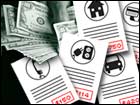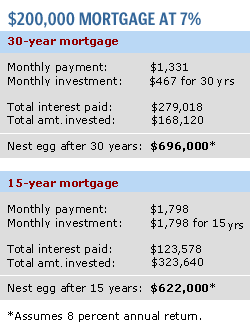
NEW YORK (CNN/Money) -
Like dark chocolate and red wine, a little debt may not be as bad for you as you think. In fact, it can work to your advantage if you manage it well and keep your IOU levels in check.
Now, that's not to say consumers should take on debt to leverage themselves foolishly, or to put off paying today what they will end up owing in spades tomorrow.
But there are some situations, especially in today's low interest-rate environment, in which manageable levels of debt may save you money in the long run, or at the very least not cost you much more than paying cash. In exchange, you may have more liquidity available to build your nest egg, keep your emergency reserves intact, and prevent yourself from running up high-interest credit card debt for lack of available funds.
Weigh your mortgage options
Take buying a home. Most people can't pay cash for their house, but many want to pay it off as soon as possible. As eager as you may be to throw a mortgage-burning party, figure out the cost of having one sooner rather than later. Say you can get a $200,000 mortgage at a fixed rate of 7 percent. If you pay it off over 30 years, you'd have a monthly payment of $1,331. If you pay it off over 15 years, you'd pay $1,798 a month, or $467 more. Certified financial planner Jill Gianola of Columbus, Ohio, argues you might actually save more money over time by choosing the 30-year option. Here's how:

On top of your $1,331 monthly mortgage payment, you invest $467 a month for 30 years. At the end of that time, you will have paid off your house and you'll have a $696,000 nest egg to boot, assuming an 8 percent annual return.
Now let's say you chose the 15-year mortgage. Since you don't have that spare $467 to invest every month -- it's going to your lender -- you begin investing the day your mortgage is paid off and you invest an amount equal to your old mortgage payment ($1,798) every month for 15 years. You end up with a nest egg of $622,000, assuming an 8 percent annual return. That's $74,000 less than if you had chosen the 30-year option.
While it's true that you will pay more in interest on the 30-year loan (about $155,500 more), you have to invest far more of your own money under the 15-year scenario (about $155,500 more) just to achieve that $622,000 nest egg. "The calculations [for the 30-year scenario] assume you pay all that interest and you'll still be $74,000 ahead," Gianola said.
She also calculates the 30-year mortgage would give you an additional $17,000 in tax savings in the first 15 years of payments compared with the shorter-term mortgage. That's because more of your payments in the early years of the 30-year mortgage would be going toward interest, which is deductible.
Keep in mind: For this scenario to pay off you need to be religious about making your monthly investments and have the risk tolerance to invest in a portfolio that has the potential to throw off 8 percent a year, said certified financial planner Joel Framson of Los Angeles.
Minimize what you pay
Unlike the home-buying scenario, it's easier for some people to pay cash for a car. But doing so may mean you pay a higher price for your wheels. Dealers may charge a premium for cash purchases since they tend to make more money on financing deals. And even though 0-percent financing deals are no longer ubiquitous, there are many rock-bottom rates to be had, some as low as 0.9 percent. So if you can find one -- a good place to check is the Incentives and Rebates page at Edmunds.com -- you might be better off keeping your cash reserves liquid and earning interest on them while your car depreciates in value, a process that starts as soon as you drive off the lot.
Student loans are an even better example of "good" debt, since those college and graduate degrees can boost your salary and the loan interest you pay is often deductible. In fact, there's never been a better time to take out a federal student loan. Come July 1, the variable rate on the federal Stafford and PLUS loans will hit all-time lows that will remain in effect through June 30, 2003. Those who already have student loans might do well to pay down their highest-rate balances and consolidate the rest into one low, fixed-rate package. If you can lock in the historic low rates for the remainder of your loan, you may save yourself a great deal in interest payments over time.
A word to the debt-averse
If you're the sort of person who is completely debt-averse -- you pay cash for everything and shun credit cards -- you certainly deserve kudos for swimming against the tide.
But there can be some disadvantages to not establishing a credit history, even if you have no intention of taking out a loan. Often landlords, insurers and employers will check applicants' credit scores and credit reports in making their decisions. "You can certainly get along without it," said Craig Watts, a spokesman for Fair Isaac, creator of the widely used FICO credit score. But, he noted, without a credit history you may face delays in approval or may need to shop around a little longer for what you need.
To generate a credit score, you need to have an established credit account that is at least six months old. People with the highest scores tend to have the lowest balance-to-limit ratios, several credit accounts, and a long history of making on-time payments, Watts said. The shorter your credit history and the fewer accounts you have, the more potential for volatility in your score, he noted. In other words, one late payment will have a more negative impact on the score of a person with a thin credit history than it will on the score of someone with a long track record of managing several accounts well.
So, what's your number?
What's the perfect level of debt? Ideally, experts say, your total monthly long-term debt – including your mortgage, loans, and credit card payments – shouldn't exceed 36 percent of your gross monthly income.
But that can be hard to maintain in areas like Los Angeles and New York, where housing prices make the stratosphere seem vertically challenged.
| |
 RELATED ARTICLES
RELATED ARTICLES
| |
| | |
| | |
|
The truth is, there's no one number that's right for everyone. That's in part because people's psychological threshold for debt can differ dramatically. Framson finds a lot of debt decisions aren't based on logic so much as childhood money experiences. "A lot of that will flavor the decisions a person makes and they're often not objective decisions," Framson observed, noting that the Depression-era generation, for example, have an almost "genetic stamp against debt."
He also noted that he has never seen the debt-averse get into serious financial trouble, whereas those with a high tolerance for debt run the risk of getting caught short, especially when they fail to be realistic about the possibility of job loss, bear markets, and other sobering financial events.
At the end of the day, if you're willing to have some debt in your life, the perfect level for you will meet three criteria. First, it won't negatively affect your cash flow or emergency fund, Framson said. Second, it can do double-time -- that is, it helps you get something of long-term value while saving you money or at least not costing you very much in the long run. And lastly, it won't make you lose sleep at night.

|

